- bhavya gada
- No Comments
Community pollinator gardens are transforming neighborhoods across Maryland into thriving habitats for bees, butterflies, and other pollinators. These gardens support agriculture, improve biodiversity, and provide educational opportunities for communities. They focus on native plants, pesticide-free maintenance, and sustainable practices to counter habitat loss and climate challenges.
Key Highlights:
- Why They Matter: Pollinators are essential for crops like apples and cucumbers, but urbanization and climate shifts threaten their survival.
- Community Efforts: Schools, local groups, and organizations are creating pollinator-friendly spaces, often with funding and expert support.
- Examples:
- Maryland State Highway Administration: Turning roadside vegetation into pollinator habitats.
- Ocean City Green Team: Offering grants up to $5,000 for residents to create pollinator gardens.
- University of Maryland: Research gardens and green roofs that educate and protect pollinators.
- Best Practices: Use native plants like wild bergamot and goldenrod, avoid pesticides, and include features like water sources and clustered plants.
These gardens not only help pollinators but also bring communities together, reduce maintenance costs, and enhance local green spaces. Ready to start or join a pollinator garden? Maryland offers plenty of resources to help you make a difference.
Wild Ones Baltimore / Planning native garden projects in your community with Jimmy Rogers
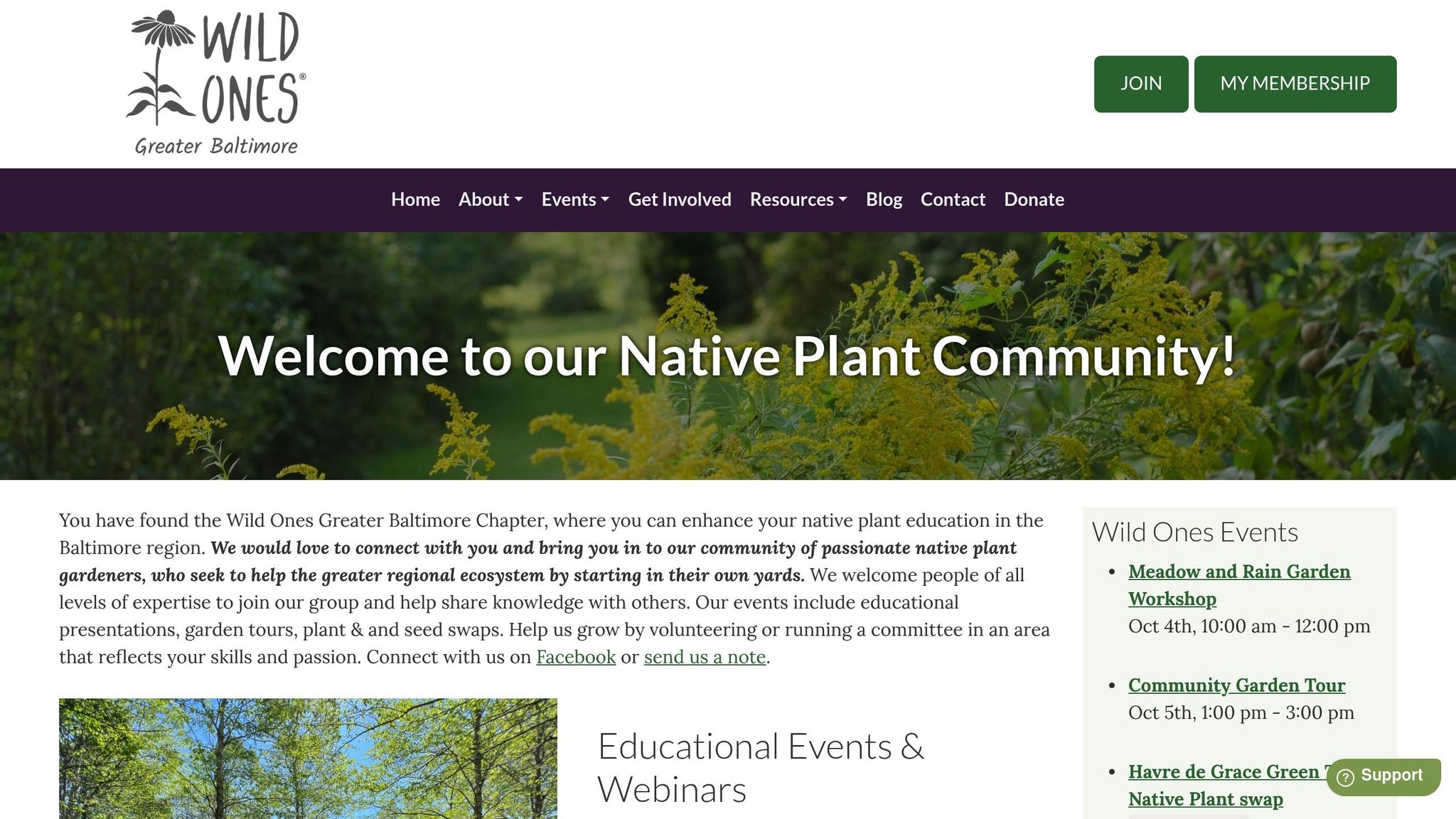
Maryland’s Top Community Pollinator Garden Projects
Across Maryland, several inspiring projects highlight the dedication of local communities to preserving and supporting pollinator populations. These initiatives not only protect essential species but also foster environmental awareness and education.
Maryland State Highway Administration Gardens
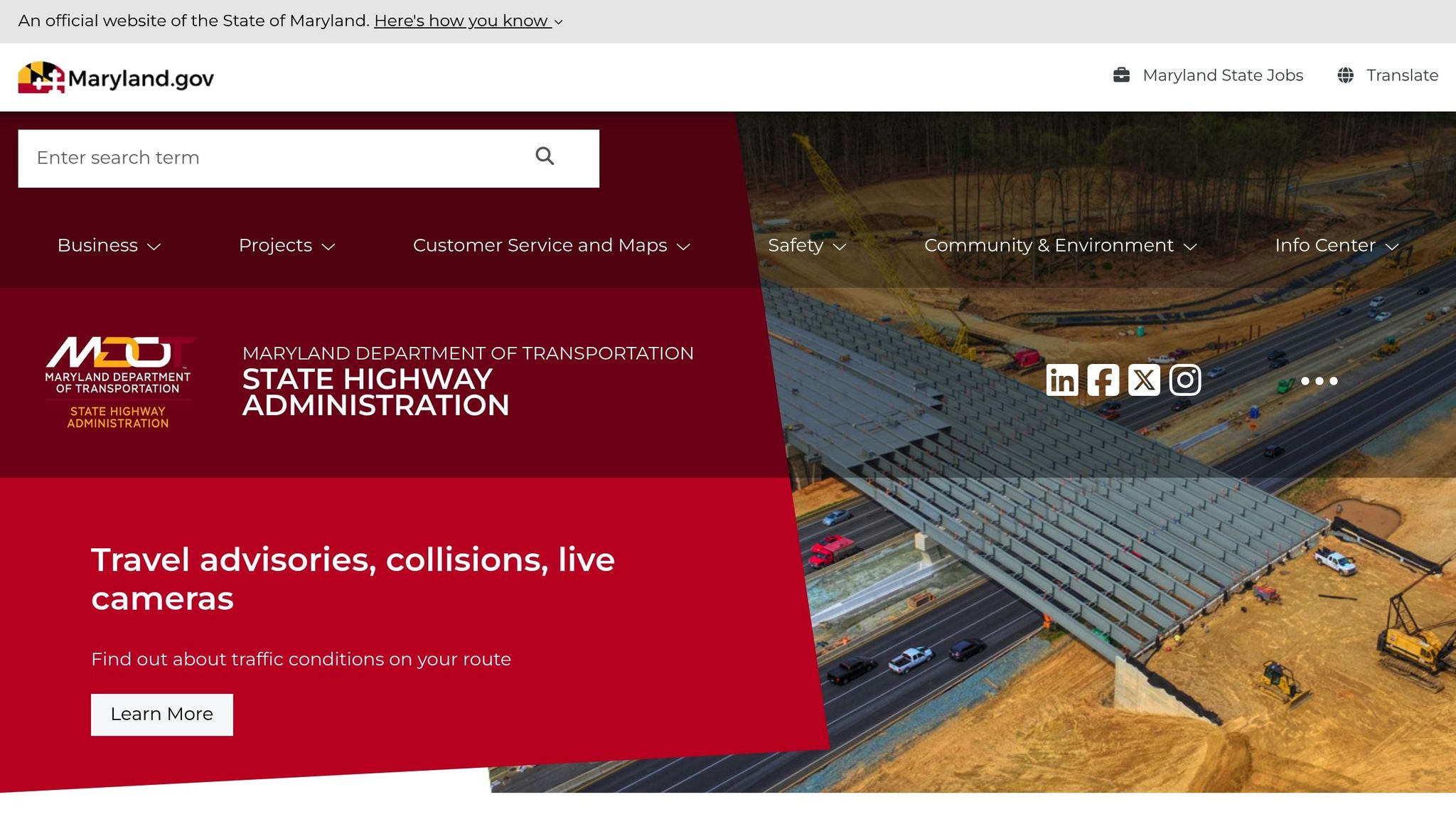
In 2019, the Maryland State Highway Administration conducted a study that revealed the potential of roadside vegetation to become thriving pollinator habitats [1]. This discovery has since spurred efforts to transform roadside areas into spaces that support bees, butterflies, and other pollinators. By integrating conservation efforts into transportation corridors, Maryland demonstrates how infrastructure can coexist with and contribute to environmental preservation.
Ocean City Green Team Pollinator Grants
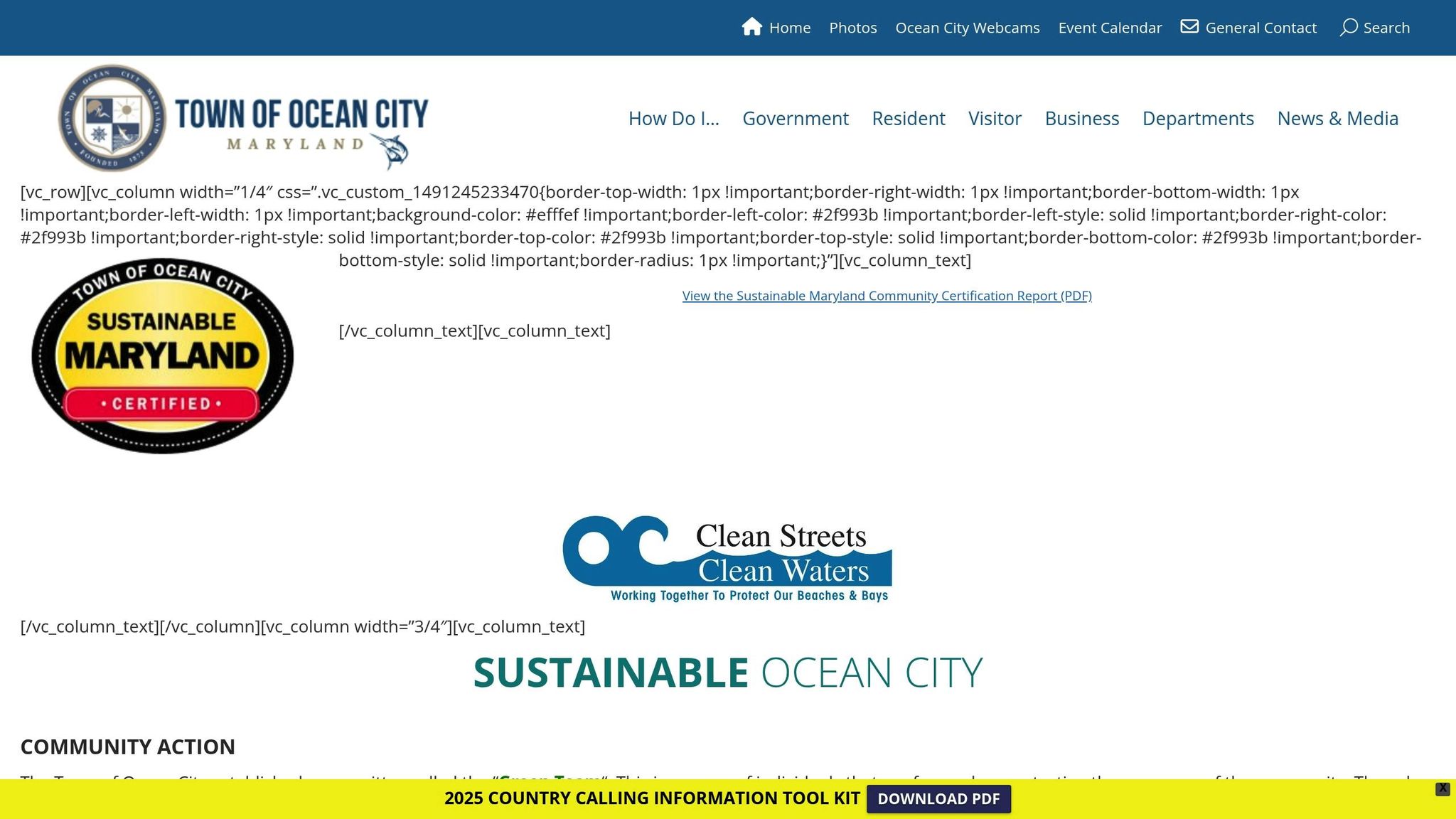
Ocean City’s Green Team has launched a grant program designed to encourage residents to create or expand pollinator gardens within city limits. Property owners can receive grants of up to $5,000 to establish these gardens [2]. This initiative emphasizes the importance of pollinators, which are essential for over 180,000 plant species and more than 1,200 crops [3]. The program addresses critical issues like habitat destruction, pollution, and the misuse of chemicals by promoting practices such as planting flowers in clusters and avoiding pesticides. Beyond supporting pollinators like bees, butterflies, moths, and hummingbirds, these gardens also improve water quality and help prevent soil erosion. The project serves as an excellent example of community-led conservation and aligns with Sustainable Maryland Action Items.
University of Maryland Arboretum and Bee Campus Gardens
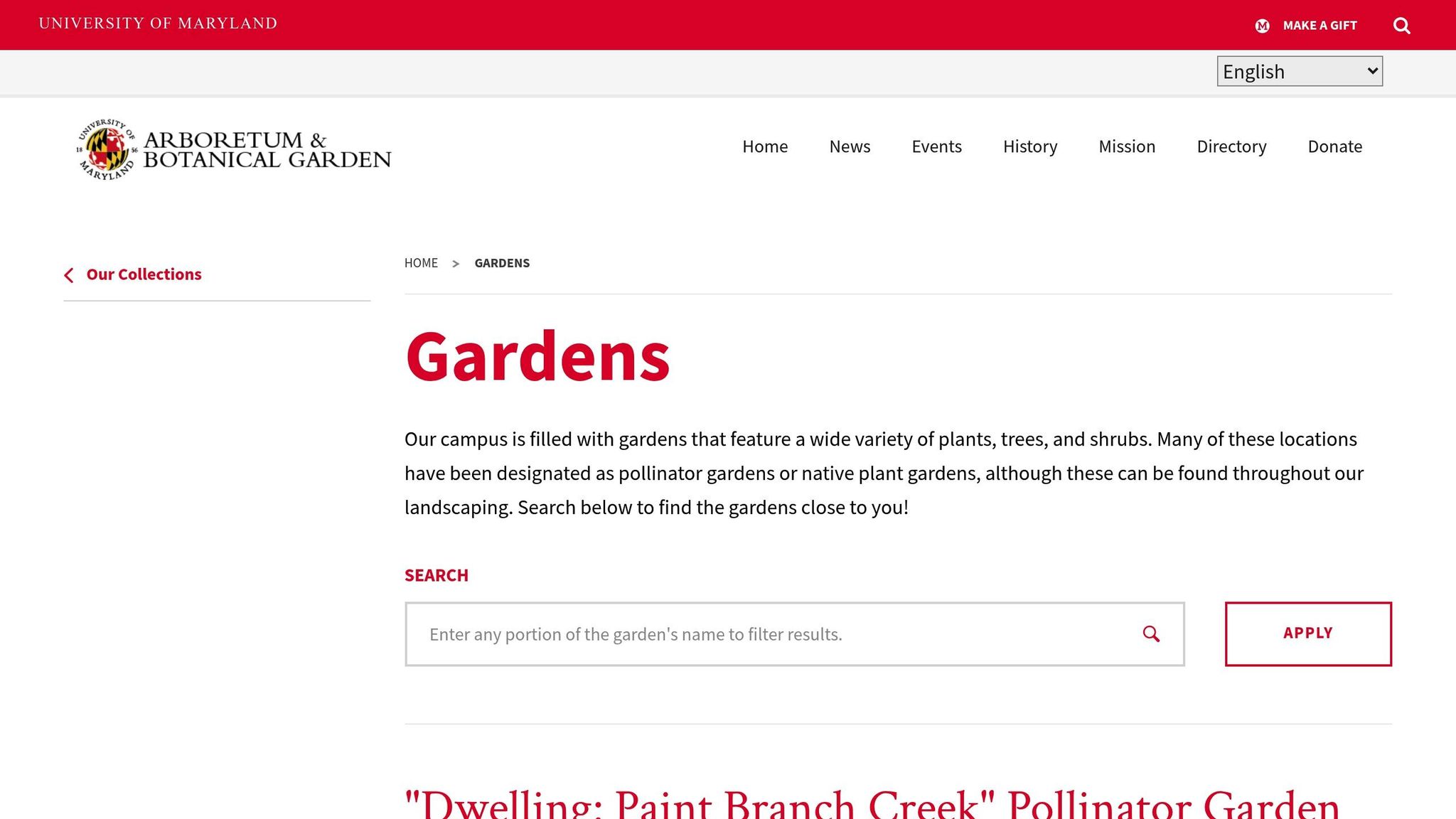
The University of Maryland has created a series of conservation gardens and green roofs that double as research and educational spaces. These pollinator-friendly habitats provide students and researchers with hands-on opportunities to study the interactions between pollinators and plants. As a designated Bee Campus, the university is committed to fostering pollinator-friendly environments, featuring native plant communities that cater to pollinators’ needs throughout their life cycles, from nectar sources to nesting spaces. These gardens also serve as demonstration sites for the wider Maryland community, hosting workshops and tours to share effective strategies for pollinator garden design and upkeep. Through these efforts, the university not only advances research but also strengthens community partnerships and educational outreach.
How Local Organizations Support Pollinator Gardens
Local organizations play a key role in turning the idea of pollinator gardens into flourishing community spaces. Through thoughtful planning, financial backing, and educational programs, these groups help ensure these projects thrive and provide lasting benefits to their neighborhoods. Their contributions extend across funding, education, and design.
Planning and Funding Support
State agencies and local groups use practical strategies to help establish pollinator habitats. Many communities offer grants specifically for creating and maintaining these gardens. Additionally, local foundations and environmental nonprofits often provide funding for projects that incorporate community education or serve multiple neighborhoods. This approach helps extend pollinator-friendly spaces across the state.
Community Education and Involvement
Education is at the heart of successful pollinator garden initiatives. University extension services and local Master Gardener programs host hands-on workshops and volunteer events, equipping Maryland residents with gardening techniques and knowledge about native plants. These efforts not only enhance skills but also encourage collaboration, transforming public spaces into interactive learning environments.
Pro Landscapes MD‘s Garden Design Services

Professional landscaping is essential for building sustainable pollinator gardens. Pro Landscapes MD specializes in designing vibrant outdoor spaces tailored to Maryland’s climate and soil conditions. They incorporate practical drainage solutions to protect native plants and add eco-friendly hardscaping, such as functional pathways and community gathering areas, to ensure these gardens are both beautiful and practical.
sbb-itb-843f8be
Best Practices for Pollinator-Friendly Landscaping
Creating a pollinator-friendly garden involves combining native plants, thoughtful maintenance, and eco-conscious hardscaping. Maryland’s unique climate, from the Chesapeake Bay to the Appalachian foothills, offers plenty of opportunities to design spaces that support local pollinators.
Native Plant Selection and Habitat Design
Selecting native plants is the backbone of any pollinator garden. Plants like purple coneflower, black-eyed Susan, and wild bergamot are not only beautiful but provide essential nectar throughout the growing season. Because these species evolved alongside Maryland’s pollinators, they’re naturally suited to thrive with less water and upkeep compared to non-native options.
Planning for seasonal blooms ensures pollinators have food from early spring to late fall. For example, wild columbine and Virginia bluebells bloom in early spring, helping bees as they emerge in March and April. Later in the year, New England aster and goldenrod provide critical sustenance for migrating monarch butterflies.
Creating diverse habitats makes room for a variety of pollinator species. Native bunch grasses can serve as nesting spots for ground-dwelling bees, while leaving 12–18 inches of plant stems intact offers winter shelter for beneficial insects. Including small water features, like shallow basins, gives pollinators a place to drink and bathe.
Clustering plants is more effective than scattering individual ones. Grouping three to five plants of the same species enhances visual cues for pollinators and improves the chances of successful pollination. Plus, it simplifies maintenance and creates striking focal points in community spaces.
By focusing on native plants and thoughtful design, you’re also setting the stage for natural pest control and eco-friendly hardscaping.
Eco-Friendly Maintenance Practices
Ditch chemical pesticides in favor of natural pest control methods, and strengthen plant health through organic soil care. Healthy soil produces stronger plants that can resist pests and disease. Adding compost to your garden enriches the soil structure and delivers nutrients slowly – just the way native plants prefer.
Conserving water is another key to low-maintenance gardening. Deep, occasional watering helps plants develop strong roots, while organic mulch retains soil moisture and suppresses weeds. Consider using rain barrels or drip irrigation systems for efficient watering during dry spells.
Letting nature take the lead can create a healthier habitat. For instance, leaving leaf litter in garden beds provides overwintering spaces for insects. Allowing some areas to remain “messy” encourages the development of microhabitats that support a variety of species.
These maintenance strategies not only reduce your workload but also complement the hardscaping and drainage solutions that follow.
Adding Hardscaping and Drainage Solutions
Eco-conscious hardscaping can enhance a pollinator garden while serving practical needs. Permeable pavers, for example, allow rainwater to seep into the ground, reducing stormwater runoff and preventing erosion. These pavers also make paths more accessible without harming delicate native plants.
Smart drainage solutions protect both your plants and the garden’s structure. French drains and dry riverbeds help manage excess water during Maryland’s heavy spring rains, while also doubling as attractive landscape features. Proper grading directs water away from walkways and seating areas, channeling it toward thirsty native plants instead.
Functional design elements can serve both people and pollinators. Stone seating areas provide comfortable spots for visitors to relax, while retaining walls made of natural stone create crevices for insects to shelter. These features also add thermal mass, helping nearby plants extend their growing season.
Pro Landscapes MD specializes in combining sustainable hardscaping with effective drainage to support native plants and manage stormwater efficiently.
Using locally sourced materials like flagstone or natural stone steps not only enhances the garden’s durability but also avoids problems like chemical leaching or heat buildup. These choices protect your plants, boost pollinator habitats, and make the garden more inviting for everyone.
Benefits of Community Pollinator Gardens
Community pollinator gardens are more than just green spaces – they offer a range of ecological, educational, and economic perks. By bringing people together and supporting local ecosystems, these gardens create lasting value for neighborhoods and the environment.
Biodiversity and Ecological Benefits
Pollinator gardens act as vital refuges for biodiversity, especially in urban and suburban areas. Take Emmanuel Parish’s pollinator garden in Western Maryland, for instance. With over 33 native plant species, it provides essential habitats for pollinators and wildlife alike[4].
Switching out traditional lawns for native plants has its perks. It saves water, reduces the need for chemicals, and improves water quality[4]. Plus, cutting back on maintenance, like frequent mowing, means a smaller environmental footprint overall.
Community and Educational Impact
These gardens don’t just serve nature – they bring people together. Pollinator gardens often become community hubs where residents gather for planting and upkeep. A standout example is the Broadway East Community Pollinator Garden. On June 3, 2023, groups like the Broadway East Community Association, The 6th Branch, National Wildlife Federation, and Garden for Wildlife collaborated to create a Certified Wildlife Habitat®[5].
Education thrives in these spaces too. The Mariner Point Park Rain Garden, installed in Spring 2022 by students from the Harford County Master Watershed Ambassador Program, features signage that educates visitors on native plants and stormwater management[6]. In areas like Broadway East in Baltimore, these gardens also address environmental justice issues by offering much-needed green spaces[5].
Experienced gardeners often share their expertise, encouraging sustainable practices and inspiring people of all ages to get involved.
Long-Term Value and Visual Appeal
Pollinator gardens are a win-win for neighborhoods, improving both aesthetics and property values while cutting maintenance costs. From the vibrant blooms of spring wildflowers to the textured seed heads of fall, these gardens offer year-round visual interest. Add to that the lively activity of butterflies, bees, and birds, and the result is a dynamic, eye-catching landscape[4].
For example, Emmanuel Parish redirected funds previously spent on lawn care to support other community programs after establishing their garden[4]. Thanks to the hardiness of native plants, these gardens can handle extreme weather with less need for irrigation or erosion control. Professional landscaping services, like those offered by Pro Landscapes MD, further enhance these benefits by ensuring proper site preparation and drainage, creating sustainable outdoor spaces the entire community can enjoy.
Building Maryland’s Future with Pollinator Gardens
Across Maryland, community pollinator gardens are transforming neighborhoods into vibrant hubs of native plant life while fostering a deeper connection between people and the environment. These gardens are more than just beautiful spaces – they’re a testament to how local efforts can tackle environmental challenges and strengthen community bonds.
Organizations like the Maryland State Highway Administration, Ocean City Green Team, and the University of Maryland are at the forefront of expanding pollinator habitats statewide. Their work not only supports the environment but also brings neighbors together, creating a shared sense of purpose and pride.
The best part? You don’t need to be a gardening pro to get involved. Many successful gardens start with small groups of passionate residents teaming up with local organizations for guidance and resources. Whether you’re looking to join an existing project or kick off a new one in your area, there are plenty of opportunities in Howard County, Montgomery County, Carroll County, Frederick County, Prince George’s County, and Baltimore County. These collaborations lay the groundwork for expert support to ensure these gardens thrive.
For communities starting pollinator gardens, professional design can make all the difference. Pro Landscapes MD offers sustainable garden design and native plant installation services throughout central Maryland. Their expertise in site preparation, drainage, and eco-friendly landscaping not only reduces upkeep but also improves stormwater management and boosts property values.
The pollinator garden movement in Maryland is gaining momentum. By supporting current projects or starting new ones, residents in places like Bethesda, Columbia, Ellicott City, Gaithersburg, and Silver Spring can play a role in creating greener, more connected neighborhoods. Now’s the time to take action and help build a stronger, more sustainable future.
FAQs
How can I help create a pollinator garden in my Maryland community?
Getting involved in creating a pollinator garden in Maryland is a fantastic way to help support the local environment. Start by planting native flowers that bloom throughout the year. This ensures pollinators have a consistent supply of nectar and pollen. A mix of native plants is key, as it attracts a variety of pollinators. Also, steer clear of pesticides to keep your garden safe for bees, butterflies, and other beneficial insects. Adding features like nesting sites can further enhance the habitat.
You might also consider joining local efforts like habitat registration programs or community garden initiatives. These not only improve your area’s green spaces but also bring people together. If you’re looking for guidance on creating and maintaining a pollinator-friendly garden, reaching out to professional landscapers can be a great option to ensure your garden flourishes all year long.
Why should I use native plants in my Maryland pollinator garden, and which ones are best to include?
Native plants play a crucial role in pollinator gardens by offering the nectar, pollen, and shelter that local pollinators such as bees, butterflies, and hummingbirds depend on. Because these plants are naturally suited to Maryland’s soil, climate, and ecosystems, they tend to be tougher and require less upkeep. Beyond that, they sustain pollinators throughout their entire lifecycle, including serving as host plants for caterpillars, which are a key part of the food web.
If you’re planning a pollinator garden in Maryland, consider adding plants like American hazelnut (Corylus americana) and Summersweet (Clethra alnifolia). These species are well-suited to the region and promote biodiversity, creating a garden that’s both vibrant and self-sustaining.
What help is available for Maryland residents who want to start a pollinator garden?
Maryland residents have plenty of resources to help them create pollinator gardens. The University of Maryland Extension offers expert guidance on choosing native plants and designing spaces that attract and support pollinators. Similarly, the Maryland Department of Natural Resources runs programs like Maryland Wild Acres, which promotes pollinator-friendly practices and provides clear, actionable guidelines.
For those seeking inspiration, local efforts such as the pollinator gardens in La Plata and Bowie showcase how communities can collaborate to build thriving environments for pollinators. These initiatives often share practical advice, planting strategies, and ongoing support, empowering residents to make a difference right in their own backyards.

















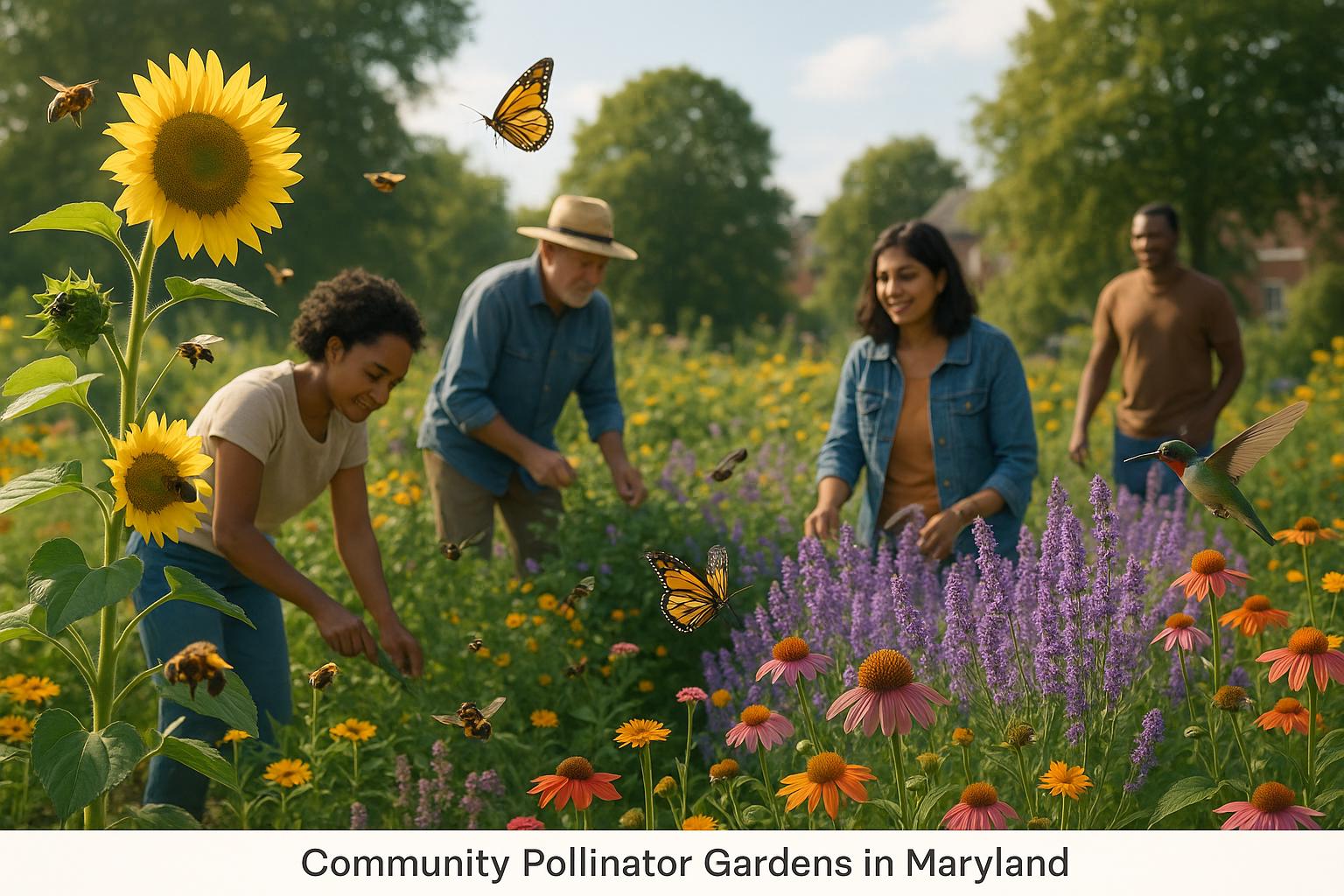
Chat with Us